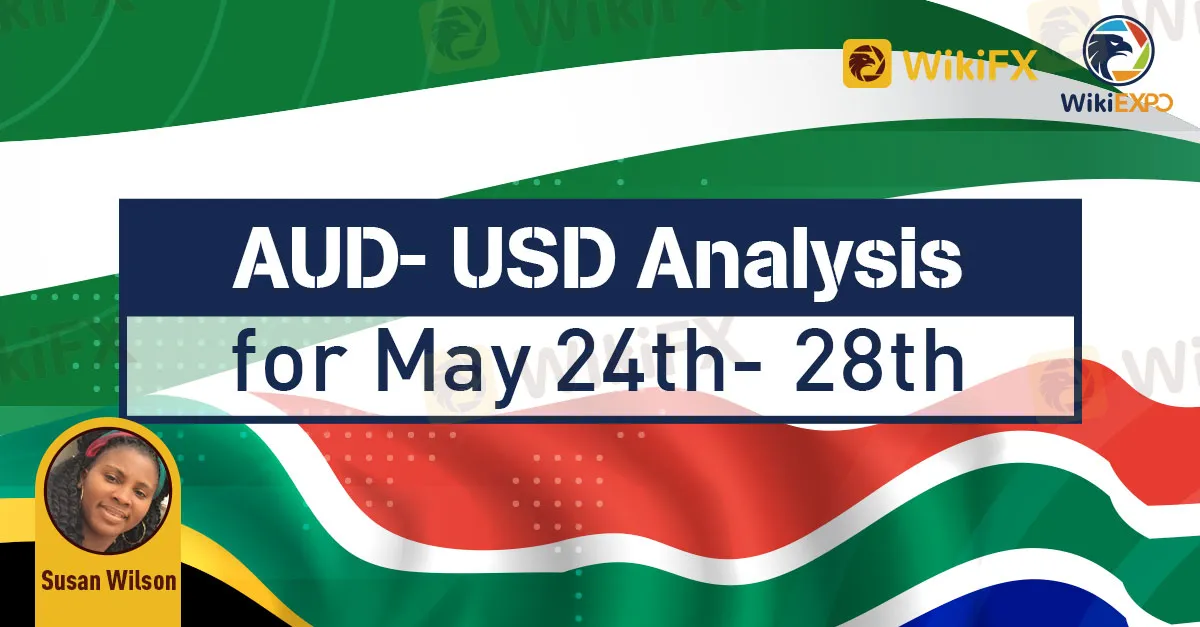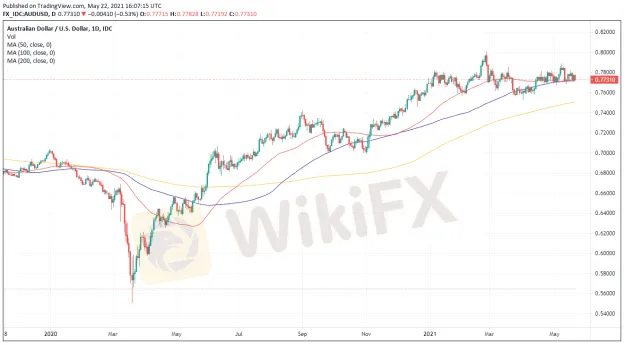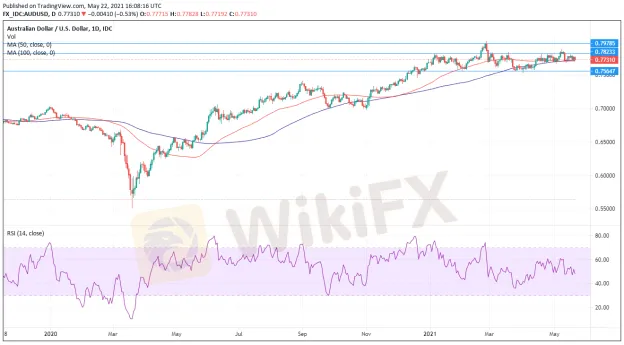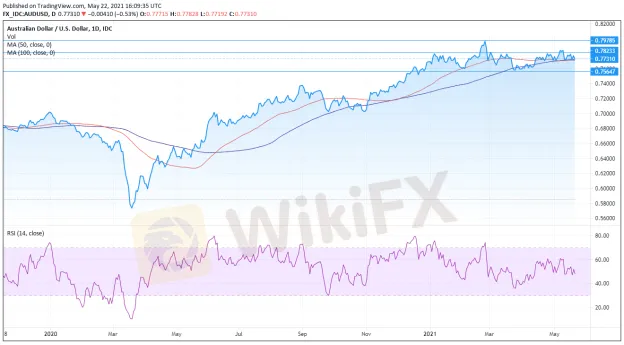简体中文
繁體中文
English
Pусский
日本語
ภาษาไทย
Tiếng Việt
Bahasa Indonesia
Español
हिन्दी
Filippiiniläinen
Français
Deutsch
Português
Türkçe
한국어
العربية
AUD- USD Analysis for May 24th- 28th
Abstract:AUD- USD is neutral in the long term, technically, moderate bearish possibility.

US Fed inflation bonds yields‘ series continued is again the major market’s dictator. Reports that some policymakers of the United States are available to deliberate a slimmer monetary plan caused an equity sell-off and raised yields more, giving the dollar a provisional break last Wednesday.
The RBA also released the Proceedings of its newest meeting. Hypothetical interests were expecting clues of a slimmer monetary strategy, as policymakers confirmed that they would revisit it coming this July. The AUD continues to remain submerged, in spite of yet another reason that would have improved the currency. Gold ascended to $ 1,889.96 per troy ounce, its peak from early January.
Is this a bearish setup for the duo? Not at all, really. The greenback would recuperate if the Fed makes a significant move toward plummeting numerical facilitation.

Downward figures revealing in Australia
Australian data could not amaze the market. The WPI was up 1.5% YoY in the first three months of the year, a little improved than the previous 1.4%, but way below average and the RBAs 3% goal.
Talking about unemployment, the region lost 30,600 vacancies versus the anticipated 15,000 rise. The input rate dropped to 66.0%, which enhanced the unemployment rate reducing to 5.5%, an unreal advancement.
The United States will release some important data in the coming week. The major event will be April Durable Goods Orders, booked for Thursday and foreseen at 0.80% MoM. The States will also release Q1 Personal Consumer Expenditures and the usual weekly employment-related data.
AUD- USD Technical Analysis
AUD-USD pair continues to trade within the 0.77-0.78 confines, an area it has dwelled for more than a month now. In between, the duo attained 0.7890, but the green move has cut short. The weekly chart displays that the pair continues to hold just ahead of a slightly bullish 20 SMA, which stays far above the lengthier ones. Technical pointers twisted north, presently standing on unbiased grounds.
In the daily chart, the duo is unbiased. It continues to find traders around the bullish 100 SDMA, while technical gauges are penetrating their midst, although without sufficient energy to affirm an imminent leg north.
The duo has a direct support around the 0.7690 zone, shadowed by the 0.7620 region. Beneath the final, a slide toward 0.7530 looks likely. Resistances come at 0.7820 and 0.7890 Mays peak.

AUD-USD Sentimental View
In the short term, the pair is viewed as unbiased, but advancing quarterly and monthly. Nevertheless, on an average, the pair is seen firm within similar levels in the different frame under study.
Generally, the most likely goals in the weekly view accrue just beneath the present level, but that deviates in the longer term, with greater odds of a touch of the 0.8000 region. The smaller moving averages continue to wander.

Disclaimer:
The views in this article only represent the author's personal views, and do not constitute investment advice on this platform. This platform does not guarantee the accuracy, completeness and timeliness of the information in the article, and will not be liable for any loss caused by the use of or reliance on the information in the article.
Read more

Key Forex Strategies
New to forex trading and looking for simple and effective trading strategies? We got you covered! In this quick guide, we'll explain some of the key forex strategies which are easy to digest. So, let's start!

Fundamental vs Technical Analysis
Fundamental and technical analysis play some of the most influential and critical roles in making trading decisions amongst traders today. They are widely accepted by stock, foreign exchange, indices and cryptocurrency traders worldwide. Traders use either or both of the methods to make key trading decisions in their respective markets.

Going Short of JPY Is Boosted by Yellen’s Remark on Interest-Rate Hikes Again
When interviewed by Bloomberg, Yellen, the U.S. Treasury Secretary, indicated that the USD 4-trillion budget released by Biden would be beneficial to America even if it may increase inflation and interest rates.

Brent oil is predicted of bullish repricing by Goldman Sach
According to Goldman Sachs' head of energy research, a nuclear deal between the U.S. and Iran could send energy prices higher - even if it means more supply in the oil markets. Talks are ongoing in Vienna between Iran and the six world powers - the U.S., China, Russia, France, U.K., and Germany - trying to salvage the 2015 landmark deal. Officials say there's been progress, but the conclusion of the negotiations remains unclear and oil prices have been soaring as a result.
WikiFX Broker
Latest News
Beware: Online Share Buying Scam Costs 2,791,780 PHP in Losses
5 things I wish someone could have told me before I chose a forex broker
Unmasking a RM24 Million Forex Scam in Malaysia
U.S., Germany, and Finland Shut Down Garantex Over Money Laundering Allegations
What Impact on Investors as Oil Prices Decline?
Gold Prices Fluctuate: What Really Determines Their Value?
Dollar Under Fire—Is More Decline Ahead?
Is the North Korea's Lazarus Group the Biggest Crypto Hackers or Scapegoats?
CPT Markets Secures UAE SCA License for FX and CFDs Services
What do Users say about "Titan Capital" on Trustpilot?
Currency Calculator






